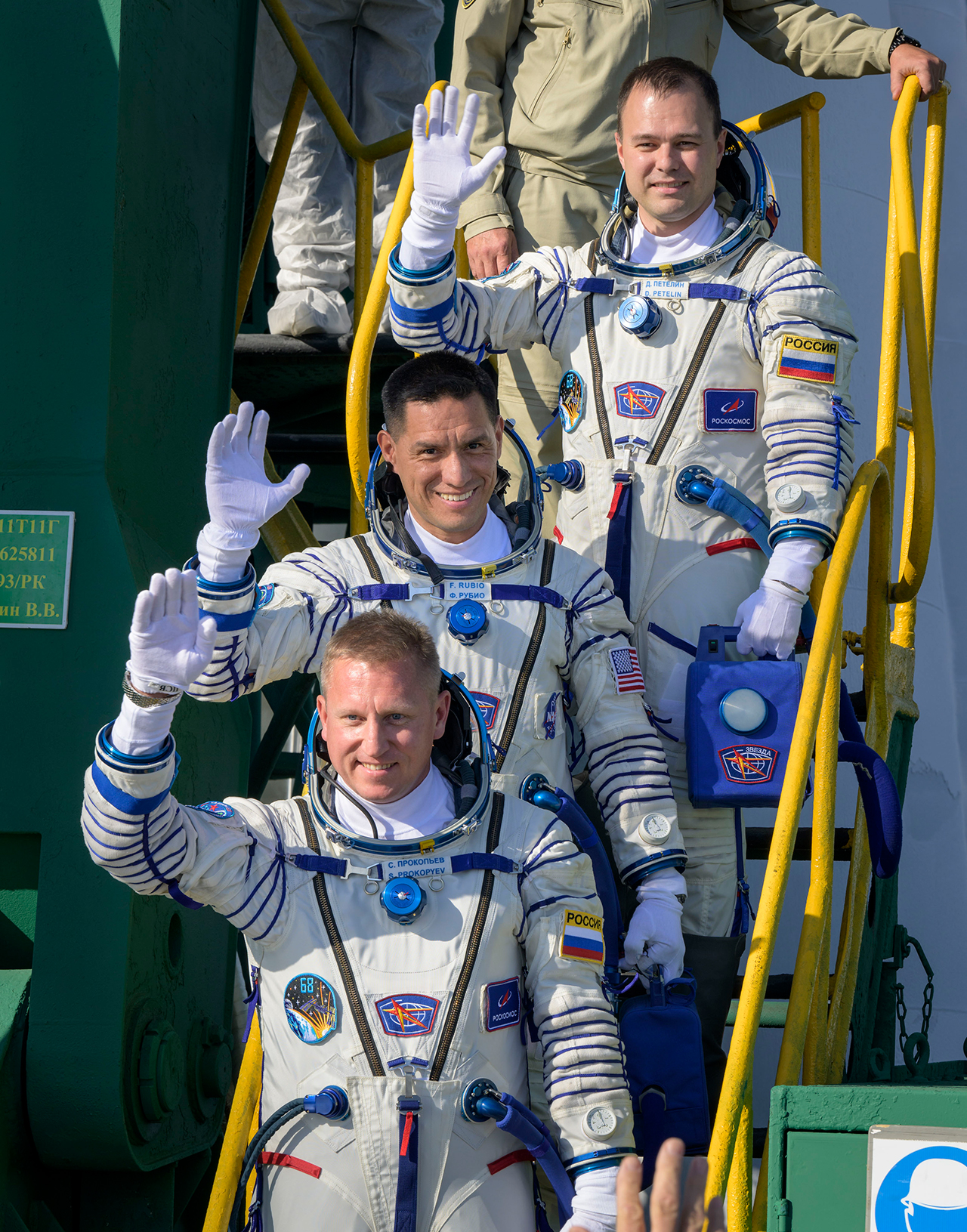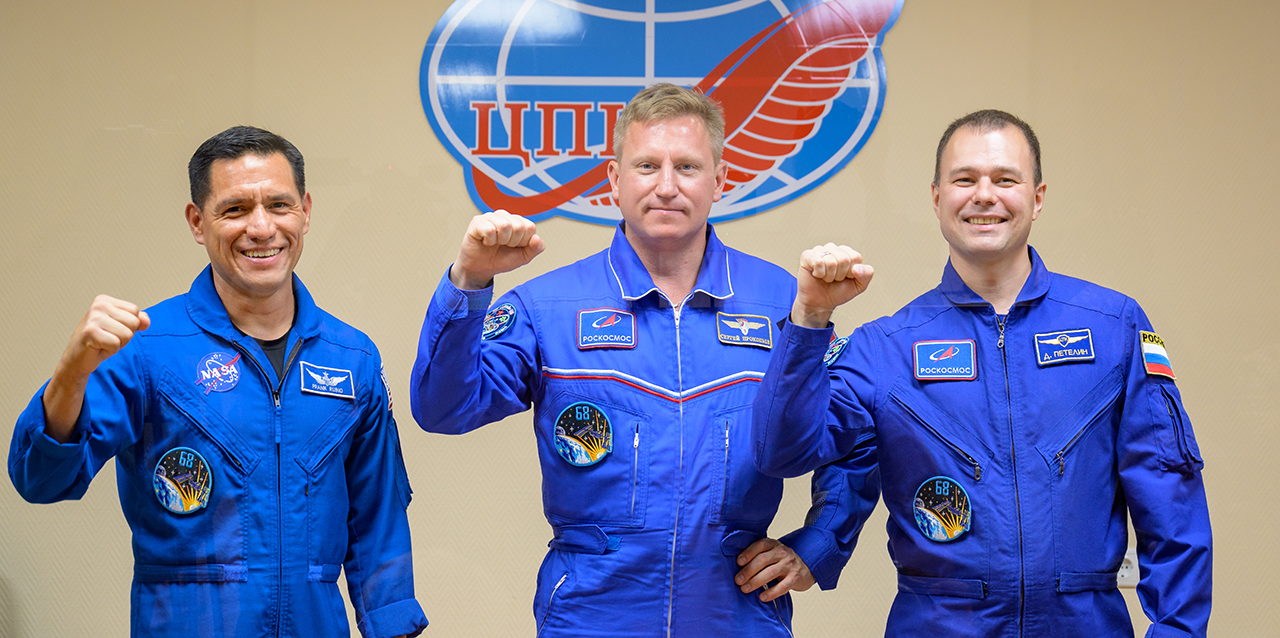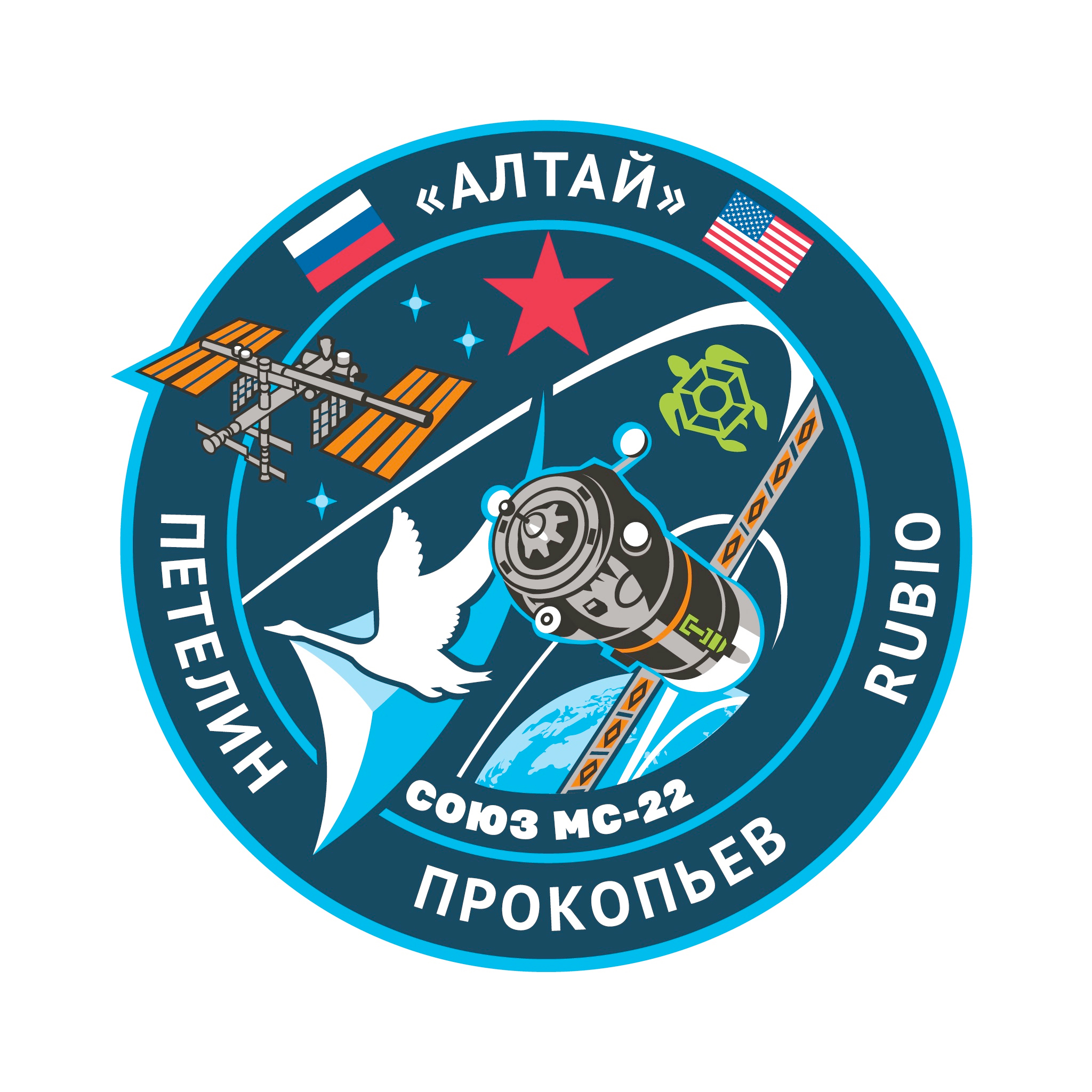Russia launches NASA astronaut to space station under new 'crew swap' agreement
Frank Rubio joined cosmonauts Sergey Prokopyev and Dmitry Petelin for the launch on Soyuz MS-22.

A U.S. astronaut has lifted off for the International Space Station, flying in a seat on board a Russian Soyuz spacecraft that was reserved through the first "crew swap" agreement since before the end of the space shuttle program than 15 years ago.
Francisco "Frank" Rubio of NASA launched with Sergey Prokopyev and Dmitry Petelin of Roscosmos, Russia's federal space corporation, on Wednesday (Sept. 21). Their Soyuz MS-22 spacecraft took flight on a Soyuz-2.1a rocket from Site 31 at the Baikonur Cosmodrome in Kazakhstan at 9:54 a.m. EDT (1354 GMT or 6:54 p.m. local time).
After a nine-minute ascent into orbit, the Soyuz crew set off to rendezvous with the International Space Station. Prokopyev, Petelin and Rubio arrived at the orbiting laboratory at 1:06 p.m. EDT (1706 GMT), docking their Soyuz to the Rassvet mini-research module after circling Earth twice. At 3:35 p.m. EDT (1935 GMT), the hatch was opened and the crew entered the ISS.
Read more: International Space Station: Live updates
After allowing time for the pressure to balance on either side of the spacecraft's hatches, Prokopyev, Petelin and Rubio will come aboard the station and join the Expedition 67 crew, including commander Oleg Artemyev, cosmonauts Denis Matveev and Sergey Korsakov, NASA astronauts Bob Hines, Kjell Lindgren and Jessica Watkins, and European Space Agency astronaut Samantha Cristoforetti.
Prokopyev, Petelin and Rubio are scheduled to spend six months in orbit.
"I think we are all super excited about the entire mission," said Rubio in a NASA press conference held in August. "We spent a ton of time training for EVAs, or spacewalks, so I think all of us are excited to hopefully participate in those. And there are some really neat biological experiments that I look forward to [such as the] biofabrication experiment, which the possibilities that that represents — possibly being able to produce human organs — would just be phenomenal in our capability to deal with human disease back here on Earth."
Breaking space news, the latest updates on rocket launches, skywatching events and more!
"Those type of things are almost mind blowing when you think about it, right? And the fact that we get to participate in a small way, but a significant way, in helping to make those a reality is truly exciting," he said.
Prokopyev, Petelin and Rubio will transition to Expedition 68 when command is passed from Artemyev to Cristoforetti, who will become the first European woman to lead a space station crew after a handover ceremony set for Sept. 28.
Cristoforetti's time as commander will be brief, though. She is scheduled to return to Earth in October with Hines, Lindgren and Watkins on SpaceX's Crew Dragon "Freedom." Their departure, as currently planned, will follow the arrival of Nicole Mann and Josh Cassada of NASA, Japan Aerospace Exploration Agency (JAXA) astronaut Koichi Wakata and Anna Kikina, Roscosmos' only female cosmonaut, on SpaceX's Dragon "Endurance."
Cristoforetti will hand over command to Prokopyev before she return to Earth.
Rubio's and Kikina's rides to space were arranged under a new crew exchange agreement between NASA and Roscosmos. By flying each other's crew members, the two space agencies ensure there is always at least one U.S. astronaut and one Russian cosmonaut aboard the station, a necessity for keeping the complex fully operational.
"I think this crew swap really represents the ongoing effort of the tremendous teams on both sides and amazing people that made this happen," said Rubio. "I think it's important when we're at moments of possible attention elsewhere that human spaceflight and exploration — something that both agencies are incredibly passionate about — remains a form of diplomacy and partnership where we can find common ground and keep achieving things together."
In return for flying Rubio on Soyuz, Kikina was assigned to SpaceX's Dragon. The crew swap, which was last in place when NASA was still flying its winged space shuttles, replaces NASA having to purchase seats from Russia. Between 2006 and 2020, NASA purchased 71 seats on Russian Soyuz spacecraft at an average cost of $56.3 million per seat (or $3.9 billion total).
Prokopyev, 47, is on his second flight into space. He previously served as a flight engineer on the station's 56th and 57th expedition crews, logging 197 days in orbit in 2018.
Petelin, 39, and Rubio, 46, are on their first spaceflight. Petelin was selected as a cosmonaut in 2012, five years before Rubio, a U.S. Army flight surgeon, began his training to become a NASA astronaut.
Soyuz MS-22 is Russia's 68th Soyuz to launch for the International Space Station since 2000 and 151st to fly since 1967.
Editor's note: This story was updated at 1:20 p.m. EDT on Sept. 21 with news of the successful docking between the Soyuz MS-22 spacecraft and the International Space Station, and again at 3:35 p.m. EDT with the news of the hatch opening and the crew entering the ISS.
Follow collectSPACE.com on Facebook and on Twitter at @collectSPACE. Copyright 2022 collectSPACE.com. All rights reserved.
Follow us on Twitter @Spacedotcom or on Facebook.

Robert Pearlman is a space historian, journalist and the founder and editor of collectSPACE.com, a daily news publication and community devoted to space history with a particular focus on how and where space exploration intersects with pop culture. Pearlman is also a contributing writer for Space.com and co-author of "Space Stations: The Art, Science, and Reality of Working in Space” published by Smithsonian Books in 2018.
In 2009, he was inducted into the U.S. Space Camp Hall of Fame in Huntsville, Alabama. In 2021, he was honored by the American Astronautical Society with the Ordway Award for Sustained Excellence in Spaceflight History. In 2023, the National Space Club Florida Committee recognized Pearlman with the Kolcum News and Communications Award for excellence in telling the space story along the Space Coast and throughout the world.




